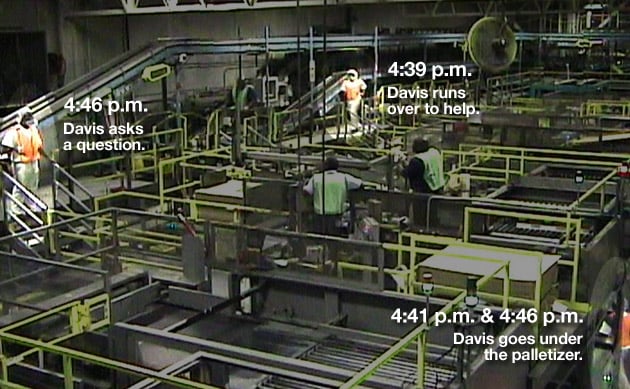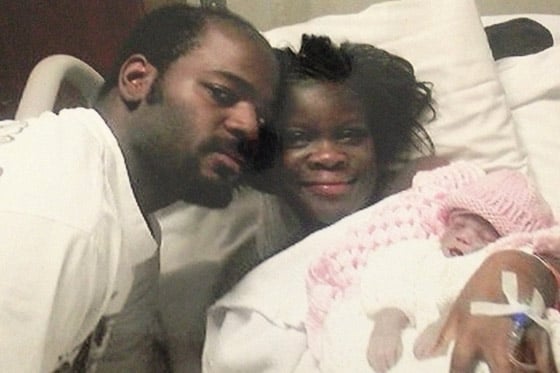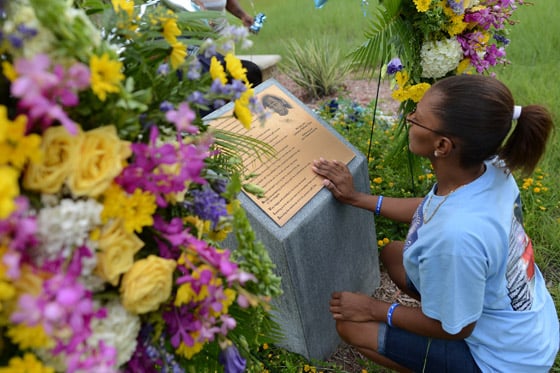Journalism in the Public Interest
Temporary Work, Lasting Harm

Ninety minutes
into his first day on the first job of his life, Day Davis, pictured
above, was called over to help at Palletizer No. 4 at the Bacardi
bottling plant in Jacksonville, Fla. Above is a composite image of the
times Davis is seen in a surveillance video before an all-too-common
story for temp workers unfolded.
A version of this story was produced by Univision and will air tonight at 6:30 p.m.
JACKSONVILLE, Fla. – This was it, he told his brother Jojo. He would
finally be able to pay his mother back for the fender bender, buy some
new shoes and, if things went well, maybe even start a life with his
fiancee who was living in Atlanta.
After getting his
high school diploma, completing federal job training and sending out
dozens of applications, Day Davis, 21, got a job. It was through a temp
agency and didn’t pay very much, but he would be working at the Bacardi
bottling plant, making the best-selling rum in the world.
Davis called his mother to tell her the good news and ask if she
could pick him up so he could buy the required steel-toe boots, white
shirt and khaki pants and get to the factory for a 15-minute orientation
before his 3 p.m. shift.
Word spread quickly through the family. “Me and my brother was like,
‘Don’t mess up now, you got to do good, don’t mess up,’ ” said his
younger sister, Nia.
It was a humid 90 degrees as Davis walked into Bacardi’s Warehouse
No. 7 to the rattle of glass bottles, the whir of fans and the clank of
industrial machines. It was his first day on the first job of his life.
He went to the bathroom and took a photo of himself in the mirror,
showing off his work clothes and orange safety vest. He texted it to his
fiancee, Alicia Lloyd, and promised he would call her during his break.
* * *
When Davis walked into the factory, he joined one of the
fastest-growing and more dangerous segments of the U.S. labor market:
blue-collar temp work.
Since the 2008 recession, companies have
increasingly turned to temporary employees to work in factories and warehouses and on construction sites. The temp industry now employs a record 2.8 million workers.
The trend carries a human cost.
A ProPublica analysis of millions of workers’ compensation claims
shows that in five states, representing more than a fifth of the U.S.
population, temps face a significantly greater risk of getting injured
on the job than permanent employees.
In California and Florida, two of the largest states, temps had about
50 percent greater risk of being injured on the job than non-temps.
That risk was 36 percent higher in Massachusetts, 66 percent in Oregon
and 72 percent in Minnesota.
These statistics understate the dangers faced by blue-collar temps
like Davis. Nationwide, temps are far more likely to find jobs in
dangerous occupations like manufacturing and warehousing. And their
likelihood of injury grows dramatically.
In Florida, for example, temps in blue-collar workplaces were about
six times as likely to be injured than permanent employees doing similar
jobs.
The findings were particularly stark for severe injuries. In Florida,
the data shows, temps were about twice as likely as regular employees
to suffer crushing injuries, dislocations, lacerations, fractures and
punctures. They were about three times as likely to suffer an amputation
on the job in Florida and the three other states for which such records
are available.
ProPublica interviewed more than 100 temp workers across the nation
and reviewed more than 50 Occupational Safety and Health Administration
investigations involving temp worker accidents.
The interviews and OSHA files revealed situations that occur over and
over again: untrained laborers asphyxiated while cleaning the inside of
chemical tanks, caught in heavy machinery such as food grinders and
tire shredders, and afflicted by heat stroke after a long day on a
garbage truck or roof.
The lightly regulated blue-collar temp world is one where workers are
often sent to do dangerous jobs with little or no training. Where the
company overseeing the work isn’t required to pay the medical bills if
temps get hurt. And where, when temp workers do get injured on the job,
the temp firm and the company fight with each other over who is
responsible, sometimes even delaying emergency medical care while they
sort it out.
The growing reliance on temps subverts one of the strongest
incentives for companies to protect workers. The workers’ comp system
was designed to encourage safety through economic pressure; companies
with higher injury rates pay higher insurance premiums. Hiring temp
workers shields companies from those costs. If a temp worker gets hurt,
the temp agency pays the workers’ comp, even though it has little or no
control over job sites.
OSHA director David Michaels said he has been alarmed by the number
of temp workers being killed on their first day on the job. Earlier this
year, he launched an initiative to raise awareness about the dangers
temp workers face and employers’ responsibilities. But despite growing
concern about temp workers’ safety, regulators and lawmakers have
struggled to make major changes, in part because they lack basic data,
such as whether temps get injured more than regular workers. Unlike the
way it monitors every other industry, the federal government does not
keep injury statistics on temp agency workers.
A
groundbreaking 2010 study
of Washington state’s workers’ comp claims found that temp workers in
construction and manufacturing had twice the claims rate of regular
workers doing the same type of work.
It’s not possible to track temp workers’ injuries nationwide through
workers’ comp records. Many states, such as New Jersey, consider
workers’ comp claims to be confidential and declined to release them to
ProPublica. In other states, such as New York, there is no way to sift
out temp workers from regular workers. In Texas, employers aren’t
required to carry workers’ comp insurance, and many fail to report their
employees’ injuries to state authorities.
The data that does exist, however, identify consistent trends,
allowing ProPublica to conduct the first multistate study of temp worker
injury claims. Our analysis covered five years of workers’ comp data,
amounting to more than 3.5 million claims, in five states: California,
Florida, Massachusetts, Minnesota and Oregon.
“Caught in” and “struck by” injuries were significantly more common
among temps, records show. In California, temps were about twice as
likely as regular workers to be stricken by heat exhaustion. And in
Minnesota, temps were at least three times as likely to be injured by
chemicals as their regular counterparts.
Within blue-collar industries, temps tend to be manual laborers, who
have higher injury rates, rather than supervisors and skilled
technicians, who have lower injury rates.
And the data shows the problem is worsening. Over the past five
years, the claims rate of temp workers has increased in Florida,
California, Oregon and Massachusetts, while that of regular workers has
held steady or fallen.
The workers’ comp system is an imperfect record of injuries. Some
workers file false claims. Some employers try to deter employees from
filing legitimate claims. But public health researchers and workers’
comp insurance experts suggested workers’ comp data likely undercounts
injuries to temp workers. One reason: If temp workers, almost none of
whom are represented by a union, report injuries, they risk being
blacklisted by their temp agency.
Bacardi said in a
statement that it has been “steadfast in its commitment’’ to safety.
But according to OSHA, the bottling plant Davis walked into on the
afternoon of Aug. 16, 2012, epitomized many of the hazards temp workers
face. It was a factory, OSHA investigators later wrote, that put
profits over safety, trained its workers to cut corners and treated its temps as
“second-class citizens” and “peons” – a portrait Bacardi disputes.
* * *
He was born Lawrence Daquan Davis, but everyone who knew him called
him Day. His mother, Tonya Washington, was 14 when she gave birth to him
in Smithfield, N.C., later moving to Jacksonville. She struggled to
make ends meet, working at day cares and dollar stores, fast-food chains
and supermarkets. But Washington and her family worked hard to raise
him right.
“You see all these little boys walking around with the sagging pants
and gold in their mouths,” Washington said. “I have to pat myself on the
back, because that wasn’t my baby.”
Davis graduated from the Fort Stewart Youth Challenge Academy, a
military-style school in Georgia. He then enrolled in Job Corps, a
federal training program for low-income youth, where he studied to be a
medical assistant.
It was there that he met Alicia Lloyd, an Atlanta student who quickly
became his girlfriend. In photographs, they can be seen making each
other laugh, Davis resting his head on her shoulder, sticking out his
tongue or the two of them pouting their lips. He called her “Lil Bit.”
They stayed up talking on the phone and texting until one of them fell
asleep.
“Day was Alicia’s Prince Charming,” said their friend Gio’Vanni
Hickerson. “I never seen them apart. One day, you looked up and they
were together like they’ve been together forever. You just look up and
they were lovey-dovey, booey-booey.”
Davis obsessed over video games such as “Call of Duty” and “Dragon
Ball Z” and lived his life on social media. On his birthday, he posted
on Facebook, thanking his mother for giving birth to him. He was a
playful older brother, sneaking up behind his sister and putting
underwear on her head, then snapping a photo and posting it on
Instagram. “My sister wit underwear on her head,” he wrote, “u can call
her captain underpants.”
Then, one day, Lloyd felt sick and went to the doctor. She was pregnant.
According to those who knew him, Davis was a head-over-heels
father-to-be. He would surprise his fiancee in class with pickles and
cheese fries.
“We were going to get a house together,” Lloyd said. “He wanted to do
the whole Army thing. We were going to have two children. That’s all,
you know, the whole thing that you do when you’re married. You know the
feeling.”
Lloyd was eight months pregnant when she woke up one morning and felt
that something wasn’t right. There was blood. Her placenta had
ruptured. Doctors ran some tests.
But the baby had no heartbeat.
Davis held Lloyd’s hand as they waited for her to deliver the
stillborn baby girl. They named her A’lisa Kaniya Davis and buried her
11 days later.
“He was really hurt about it – like really hurt,” said his sister,
Nia, 17. “None of the funerals we’d ever been to had he ever cried that
hard before.”
A’lisa’s death seemed to focus him. “He was different after that,”
said his brother, Jojo, 15. “He wanted to work and move out with his
girlfriend and settle down.”
Davis wanted to go into the military, but he struggled with math and
couldn’t pass the test. So after failing again in August 2012, and with
his mother out of work, Davis took the path of many young people on
Jacksonville’s Northside, and went to the temp agencies.
The Northside is a neighborhood of modest stucco homes, discount
clothing stores and garden apartment complexes offering $535-a-month
move-in specials. It’s a place where every other store seems to be
buying gold, and where one of the most prevalent jobs appears to be
human sign.
Davis became part of what labor economists say is a national trend.
Increasingly, young men and women with high school diplomas and
vocational training find they can’t get a factory or warehouse job
without first going through a temp agency.
* * *
The very nature of temp work increases the risk of injury. Temps are
often working in a new environment, operating machines or handling tasks
they don’t have experience with and using muscles they might not
normally use.
Labor Department data shows that nationwide, a large number of
injuries occur within the first three months of work. Many temp
assignments don’t last that long. Indeed, temp worker claimants had far
shorter tenures on average than regular workers who filed claims,
according to ProPublica’s analysis of workers’ comp records. Many temps
are perpetually new on the job.
But in interviews, dozens of temp workers across the country said it
was a near-daily experience for them to see employers cutting corners on
training and equipment.
Their observations are mirrored in OSHA investigation records. OSHA found that inadequate training was a
major factor
in the death of Samir Storey, a 39-year-old father of three who
suffocated from hydrogen sulfide gas on his first day on the job at
Resolute Forest Products, one of the largest paper and pulp producers in
North America.
Every nine months, Resolute shuts down part of its South Carolina
paper mill for several days to clean a 78.5-foot-tall tank used in the
power and utilities area of the plant. In January 2013, Resolute hired a
subcontractor, Industrial Piping, to do the job. But Industrial Piping
didn’t have its workers do the job. Instead, it hired temp laborers from
Tradesmen International.
Storey was one of those temps, and he was inside the tank suspended from a harness at about 1:21 a.m. when a
toxic vapor seeped
into the tank. OSHA found that Resolute failed to inform Industrial
Piping of proper procedures and that Industrial Piping had failed to
effectively train the temp workers in using respirators and working in
confined spaces. Jermel Storey, Samir’s cousin, who was also working at
the plant that night, said at a press conference after the accident that
the training was cursory and that the instructor had given them the
answers to the safety test.
Inadequate training also played a part in the death of Daniel Collazo
Torres, 28, in December 2011. He was killed at Nestlé-owned Tribe
Mediterranean Foods in Massachusetts when he got
caught in a hummus grinder he was cleaning and was crushed between two large rotating screws. OSHA found that Tribe had
not trained Collazo and other temps how to properly shut down the machines.
Resolute, Tradesmen and Tribe declined to comment. Industrial Piping did not return calls.
It's quite common for temps to be put to work without even the most
rudimentary protective equipment, according to OSHA records and
interviews.
In Massachusetts, temp workers at fish processing plants said they
were assigned the messy job of gutting fish, but none were given safety
glasses to keep fish blood out of their eyes. Some temp workers in
Chicago said they were brought to a work site in T-shirts, only to find
that they would be working in a refrigerated warehouse. Sometimes
companies provide safety gear, but the temp agency
deducts the cost from the employees’ paychecks – as OSHA found when it investigated a large waste management company after a Houston temp worker died from heat stroke.
Travis Kidd, 24, died when he was run over by a trash compactor while
directing traffic at a county landfill in North Carolina in 2010. OSHA
inspectors found that, unlike direct employees, Kidd, a temp from
WorkForce Staffing, was not provided with steel-toe boots for the
slippery conditions or a phone to communicate with the drivers.
“Landfill management felt they were
not responsible
to require or provide Mr. Kidd with the same PPE [personal protective
equipment] because they considered him a temporary employee and not
their employee,” OSHA wrote in its report.
Landfill director Sam Lockridge said Kidd’s death was an accident and
that he’s not convinced the boots would have saved his life. A manager
who answered the phone at WorkForce Staffing said it wasn’t true that
Kidd wasn’t given the same safety equipment as the landfill’s employees.
She declined to discuss the case further and hung up the phone.
Heat stress is another problem that hits new workers especially hard.
Federal health and safety officials say that it’s important for
employers to acclimate workers to high temperatures by exposing them to
those conditions for progressively longer period of times.
Mark Jefferson, a temp worker from Labor Ready near Trenton, N.J.,
hadn’t worked outside in the heat
for nearly three weeks when he was assigned to a long day collecting
trash for Waste Management during a heat wave in 2012. After nine hours
of throwing garbage into the truck in 90-degree heat, Jefferson told the
driver he couldn’t go on and walked away from the vehicle.
The driver called the dispatcher, who told him to pour water on Jefferson and
finish the route,
according to police. But when the driver found him, Jefferson was
convulsing and mumbling. His internal temperature reached 106.9 degrees,
and he died three days later. Jefferson, 47, was at least the fourth
temp worker in 15 years to be killed while working for Waste Management,
a company that over the years has been
repeatedly warned by OSHA about its failure to train temp workers.
Both Waste Management and Labor Ready said they were committed to
providing a safe workplace and have developed multiple levels of
training to prevent accidents.
The deaths examined in OSHA’s files match a pattern that Michael
Foley, an economist at the Washington State Department of Labor &
Industries, has found in reviewing the state’s workers’ comp files on
temp worker injuries.
“A lot of it is the scut work, the work nobody wants to do,” he said.
“The way they are being used is to protect the skilled tradesmen from
the dirty cleanup jobs. They’re brought to the site, and they’re
basically pointed in the way of the Dumpster. There’s no oversight,
there’s no supervision and they face risks they’re not experienced to
deal with.”
Melinda Finnegan, owner of Staff-Smart Staffing in Missouri, said
temp agencies should visit the work sites to understand the potential
hazards. In the past, she’s encountered companies that hire workers for
one task but then assign them to something more dangerous.
“I pull ’em,” she said. “One plant, they had them way up in the
ceiling in one of those cherry-picker forklifts. I said, ‘If you want to
do it for your own person, that’s fine; that’s your workers’
compensation costs.’”
But often, she said, if she won’t provide workers, the host company will find another temp agency that will.
* * *
Since its founder Facundo Bacardi experimented with the first batch
in a tin-roof Cuban distillery in 1862, Bacardi has grown into an
international brand synonymous with rum. It books an estimated $5
billion in annual revenue, and it has added other iconic brands,
including Grey Goose vodka, Bombay Sapphire gin and Dewar’s Scotch.
Like many factories, the Bacardi bottling plant in Jacksonville had
built temping into its normal business model, hiring dozens of temps on a
daily basis to inspect bottles, make boxes and clean up around
machines, according to OSHA records. Some temps worked for two or even
three years, never getting hired as Bacardi employees.
Bacardi’s agency of choice was Remedy Intelligent Staffing, a
franchise located in a nearby strip mall between a hair salon and a
Mexican restaurant. But the modest storefront belies its size. Remedy is
part of the Select Family of Staffing Companies, a California-based
chain that grew dramatically in the mid-2000s to become the
fourth-largest industrial temp agency in the United States. Select had
$1.9 billion in revenue in 2012.
Still, Select has had its share of problems. In 2011, it was handed a
$50 million jury verdict finding it had committed fraud in an effort to
lower its workers’ comp costs; the company settled with the California
state insurance fund for an undisclosed amount. In Chicago, it used
immigrant labor brokers known as
raiteros,
who, workers say, took advantage of them with high fees. A few months
after Davis’ first day, a Select temp in North Carolina was killed after
getting caught in a machine at a Melba toast factory.
Select spokeswoman Wendy Ballard referred calls to Brian Rose, who
owns the Select franchise office that hired Davis. Rose did not return
calls or emails.
According to OSHA investigative files from 2012 and 2013, the Bacardi
factory where Davis landed his job had for years been operating with
“plain indifference” and an “intentional disregard” for safety rules.
“Routinely,
bottles would fall
from the conveyors when a case of bottles became wet from damaged
bottles inside the cases,” an OSHA inspector wrote. The sticky flavored
rum would leak onto the rollers, compounding the problem. But whenever
the operator stopped the conveyor, the other cases would slam into one
another, causing more bottles to fall 10 feet and shatter on the floor.
Despite this, and despite a recommendation from an outside consultant that employees wear
hard hats when working under the conveyors, Bacardi failed to require them and failed to fix the problem.
The worker who ran the giant machines that pushed and stacked the
cases of rum onto pallets was in a race against production quotas. Often
overseeing multiple palletizers by himself, he would run across
catwalks and up small bridges, which had been built over the conveyors,
to ensure the cases stayed in line. Sometimes, operators of the machines
tripped or nearly banged their heads. One employee who told OSHA he was
“working three shrink wrappers and five palletizers at the same time,” recalled a near miss when his right leg almost got caught by a mechanical rake.
One of the most basic tenets of factory safety is that when you shut
down a machine to service it, you don’t just hit the off switch; you
also disconnect the power source and lock the machine to ensure it
doesn’t start up accidentally.
But at Bacardi, employees rarely did this when working inside the
palletizers, for fear of slowing down production, according to OSHA.
While they had received general training for the shutdown procedures
known as “lock out/tag out,” several operators said they had never
received specific training on the palletizers. The security officer who
was supposed to periodically ensure that workers knew how to lock the
machines didn’t know how to do it himself. Even the health and safety
manager, Lesley Toke, and the bottling manager, Tom Brouillette,
incorrectly stated
that workers could enter machines briefly without locking them, OSHA
said. In fact, during the OSHA inspection, Brouillette himself
reached into a machine while it was running, according to investigators’ notes.
While instructions were taped to the palletizer, they were
“convoluted and confusing,” an OSHA inspector wrote. The fact that workers didn’t know how to shut down machines properly had been an
item of discussion
during monthly safety committee meetings since 2010. But Bacardi failed
to fix the problem. Instead, investigators wrote, “the employer had
trained their operators to cut corners” and keep the lines moving.
About a week before Davis started, a Bacardi worker told OSHA,
Brouillette held a meeting with staff to show them that production
statistics were
“in the red”
and that they needed to pick up the pace. How would they feel, he
warned, if their pay was cut to 32 percent of their current wages?
Brouillette declined to comment, and Toke did not return calls.
Bacardi is
“production, product and profits oriented,”
an OSHA investigator would later write. “They do not want to slow down
production and spend funds on temporary employees who may not be in
their facility day-to-day. Not training these temporary employees saves
the company valuable training time. This would equate to [Bacardi]
showing ownership of the employee and establishing more risk for their
company, which they are trying to limit.”
Alise Cherry, the night coordinator for Remedy at Bacardi, told OSHA,
“When people come in, they don’t tell them what not to do.”
* * *
As troubled as the Bacardi factory seems, the situation wasn’t that
different from other work environments that temp workers describe.
Gretchen Purser, a sociologist at Syracuse University, said she
routinely encountered unsafe situations when she went undercover to work
as a temp laborer for three years in Baltimore and Oakland, Calif.
By doing so, she said, she also learned several methods that temp
labor agencies use to discourage their workers from reporting injuries.
First, she often had to sign day-to-day contracts, which stated that
at the end of each workday, temp workers will be “deemed to have quit”
until they report to the dispatch hall the next morning. At the end of
the day, before receiving her wages, she typically had to sign a form
saying that she didn’t encounter any unsafe work conditions.
Then there is what’s known in the industry as a “DNR,” which is short
for “Do Not Return.” Essentially, any host company can write “DNR” on
the back of the work slip for any reason, telling the agency not to send
that worker again. The more DNRs a worker gets, the less likely he is
to be assigned, Purser said.
Purser recounted one job where she worked as a traffic flagger on a
rural road that was under construction. She said that she and her
co-worker were stranded for nine hours in 100-degree heat without a
break and without access to water. Finally, her co-worker left his post
to find out when they could leave. Both of them went back to the agency
with a DNR on their slips.
“It’s very difficult to stand up for your own safety,” she said, “because the end result is a DNR.”
This is a major reason why temps may get injured at even higher rates
than the ProPublica analysis showed. “The temp agency is in this
position of rehiring them over and over again or not hiring them,” said
Linda Forst, an environmental and occupational health sciences professor
at the University of Illinois at Chicago. “So that’s a huge
disincentive to report” workplace injuries, she said. “I think the
number of temp workers who report is really low. I think it’s the tip of
the iceberg.”
One temp worker in the Chicago suburbs showed a visitor a large
purple mark running the length of her shin, which she said remained
three years after she tripped at a Philips Norelco warehouse and fell
onto a pallet. She said a supervisor saw what happened and told her she
would get help. But no help came. So the woman, who asked not be
identified, worked through the pain, and the local taxpayers picked up
the bill when she went to the county hospital several days later with a
blood infection.
“I didn’t say anything else to her, because I knew if I complained
again, the temp agency wouldn’t send me to work anymore,” the woman
said.
Philips Norelco did not return calls for comment.
Workers’ comp documents obtained by ProPublica show that some temps have lost work after filing claims.
Jose Miguel Rojo worked as a temp for eight years at Great Kitchens, a
Chicago-area factory that makes frozen pizza for Walmart, Target and
Trader Joe’s. Five, sometimes six days a week, eight hours a day, Rojo
stood at the end of the assembly line, picking up six frozen pizzas at a
time and putting them in a box. Once the pallet was full, he said, he
would push it for a forklift to pick up.
Then, one day in late 2012, as he was reaching over to push the
pallet, he strained his back, medical records show. Rojo did receive
workers’ compensation. But as a condition of settling his claim, he had
to sign a statement saying that
“unrelated to this incident, [he] chose to quit and seek gainful employment elsewhere.”
So after eight years as a temp for Great Kitchens, he was gone.
Great Kitchens declined to comment. The temp agency, Staffing
Network, said Rojo quit on his own accord and was not fired for filing a
claim.
There are other reasons temp workers might be less likely to report
injuries, workers’ comp experts said. The likelihood of a worker filing
an injury claim often depends on how informed he or she is about the
process. But compared with regular workers, temps are less educated on
average, far less likely to be represented by a union and far more
likely not to speak English. In addition, many temp workers are
undocumented, making them particularly wary of formal complaints.
In central New Jersey, many workers said they are not told where
they’re working – an essential piece of information should they have to
file for workers’ comp. The agency dispatchers dole out assignments
using generic Spanish names:
las pastillas, packaging pills for pharmacies;
los libros,
loading books to be trucked to superstores; or shipping lingerie to
discount clothing stores – a warehouse known universally as
los panties.
* * *
Inside Warehouse No. 7 at Bacardi, Palletizer No. 4 was having
problems on the afternoon of Aug. 16, 2012. This account of what
happened at the bottling plant is based on police reports, witness
statements, OSHA investigators’ notes, interviews and a Bacardi
surveillance video.
When the palletizer was working properly, boxes of rum bottles would
travel down a conveyor belt to a platform, where the machine would push
them into a square. When the platform was full, it would lower the cases
onto a pallet 10 feet below, then go back up to get another set of
cases.
But on this night, bottles of Bacardi Dragon Berry – a new rum
flavored with strawberry and dragon fruit – were breaking on the line.
Vincent Flournoy, the operator, wiped the conveyor with a rag.
Brouillette’s warnings about production goals weighed heavy on
Flournoy’s mind, he later told OSHA, and he was in a rush to keep up
with quotas. But cases kept getting stuck and slamming into one another.
There were a lot of broken bottles in the palletizer and under the
machine.
Flournoy, a full-time Bacardi employee, hit the emergency stop
button. According to OSHA, he was then supposed to attach a lock to
ensure that no one could come by and turn on the machine while someone
else was inside it. Then he was supposed to go downstairs and hit
another emergency stop button and insert two bars to prevent the
platform from falling. But Flournoy did as he had been trained and did
not shut down the machine completely.
“When the palletizer slows down he gets
numerous calls on his radio
about getting the lines up and running again,” according to the OSHA
file. Shutting down the machine properly “would mean slowing down
production and not reaching their goals.”
Instead, Flournoy climbed into the machine and began picking up glass
and tossing out the mangled boxes. He radioed for help, asking if
anyone had any extra temp workers.
Davis, who was inspecting bottles on the conveyor to ensure labels
were attached correctly, was called over to help. He had just started 90
minutes earlier and, a supervisor later said, he was
“gung ho” and wanted to “get the job done.”
He ran over to the palletizer, following Flournoy. Flournoy pointed
down below and told him to sweep the shattered glass from under the
machine while Flournoy and a Bacardi supervisor, Louis Wrice, cleaned
the belt and rollers on top. Davis grabbed a short broom, climbed under
the machine and began sweeping up the shards of broken bottles and
pulling out those that were still intact. The records don’t say if he
was confused about what he was doing, but investigators’ notes show that
he
paused and looked around several times, eventually going back upstairs to talk with Flournoy and Wrice.
It’s unclear what they discussed. Wrice told OSHA he had instructed Davis to wait. Others said Wrice only yelled at Davis to
get some safety gloves.
Either way, Davis went back downstairs. After pulling the glass forward
with a long broom, he went under the palletizer again and began
sweeping glass into a dustpan.
Back upstairs, Flournoy and Wrice finished cleaning, shut the safety
gate and, at 4:49 p.m., started the machine. The cases began rolling
down the line. The palletizer began pushing them into a square. Davis,
who was still underneath the machine, began to stand up halfway. But
just then, the platform carrying as many as 60 cases of rum, weighing
about 2,000 pounds, came crashing down.
“It was like an elevator coming down on him,” Jeffrey Romeo, OSHA’s assistant area director, wrote to colleagues in an email.
Flournoy and Wrice
heard a yell. They raced downstairs and tried to pry up the platform. They climbed up and started pulling cases off. But nothing worked.
“Jacksonville 911,” the operator answered.
“Yes, ma’am, I need an ambulance.”
* * *
“That whole day, I was waiting on him to text me or call me and tell
me about his day,” Alicia Lloyd said. “I tried texting and calling, but
there was no answer.”
Davis’ mother, Tonya Washington, hadn’t heard from him, either. “You
know, guys, it’s a new place,” a family friend reassured them. He was
probably socializing and meeting his new co-workers.
But Day Davis never made it to his first break.
When paramedics got to Bacardi a few minutes after the accident, they
found that the weight of the platform had crushed him. Davis died right
there on the factory floor.
Unaware of what had happened, Washington was getting ready to pick
him up at the end of his shift when she heard a knock on her apartment
door. It was 10:15 p.m.
“I knew it couldn’t have been anything good for a detective to be
coming to my house,” she said, sitting at her kitchen table a year
later. “He asked if I was Tonya Washington, and I told him, ‘Yeah.’
That’s when he said there was an accident and told me that Lawrence was
killed.”
She removed her glasses and rubbed her eyes. After about two minutes of silence, she continued.
“I asked them if they were sure, and they said they were positive,
and that’s when they handed me his identification,” she said. “After
that, I don’t know what to tell you. It was just a long, long period of
numbness.”
Somebody had to tell his fiancee. So around 11 p.m., Davis’ sister,
Nia, called. “She couldn’t tell me what was wrong,” Lloyd said. “I heard
her voice just crackle, and then her brother got on the phone, and he
couldn’t tell me. Someone else got on the phone, I don’t know who it
was, but they finally told me he had passed away.”
* * *
Almost immediately, the finger-pointing began over who was
responsible for the accident. Bacardi insisted to OSHA that it was
Remedy’s job to train temp workers. In fact, Bacardi didn’t even provide
them with any safety gear. It was the temp agency that supplied the
orange vests, gloves and safety glasses. Remedy told OSHA it only showed
temp workers a brief safety video and insisted that it was Bacardi’s
job to train them.
“The company appears to have attempted to
shift blame
to its temporary agencies,” investigators wrote. “They have taken the
position that the employee does not belong to them; therefore they are
not responsible for their safety.”
Such disputes are common when temp workers get hurt, a review of accident files shows.
After an employee was crushed to death by three 800-pound bales of
cardboard at Sonoco Recycling in North Carolina in 2010, a company
representative told an OSHA inspector,
“We don’t train temps.”
Soex West Textile Recycling had a novel defense when California OSHA
fined it after two workers lost part of their fingers in the same
machine doing the same task within a span of a month in 2009. It told
regulators it
didn’t have any employees; it leased them all from a company called Strategic Outsourcing.
Sonoco spokesman Brian Risinger said the company takes responsibility
for training all employees, including temps. Soex and Strategic
Outsourcing did not return calls.
Such confusion over who is responsible can even delay urgent medical care.
Josimar Rojas, 27, was working as a temp at Metal Impact, a
Chicago-area factory, in 2011 when his supervisor asked him to hold a
piece of metal he was working on and then accidentally drilled through
Rojas’ finger. Rojas said in an interview that he held his finger with
paper towels for an hour and a half while the factory and the temp
agency debated whose clinic he would go to. “The company said they
couldn’t look at me, because I didn’t work for them,” he said.
But before he could go to the temp agency’s clinic, he said, he had to go back to the agency’s office to fill out paperwork.
“When a lot of our guys have accidents, there’s this delay of at
least a half-hour of where is he going to go,” said Jose Rivero, Rojas’
workers’ comp attorney. “Are we sending him to our doctor or their
doctor, and whose paperwork do you fill out?”
Scott Radwan, a human resources consultant for Metal Impact,
disagreed with that assessment. “There’s never any confusion,” he said,
adding that the office has signs with the name of the temp agency’s
clinic in case of emergency.
After Davis’ death, Bacardi officials walked through the plant with
OSHA inspectors. The plant’s health and safety manager, Lesley Toke,
seemed more intent on protecting the brand than protecting workers,
according to notes the OSHA inspectors took during their visit to the
company.
“Lesley Toke made a comment,”
one inspector scribbled in his notes. “She stated we (Bacardi) had
managed to stay out of the media for a long time until just now.”
Toke predicted that the effect of the stories would not be
long-lasting, according to the notes, which quote her as saying the bad
publicity was “only for a day.”
“Plain indifference,” the inspector wrote. “This is not the first
comment of this type she has made concerning protecting product and
[the] Bacardi name.”
After the accident, the company released a statement, saying that
“Bacardi prides itself as having safety as its number one priority.”
Privately, OSHA investigators wrote a scathing response.
“They have submitted into evidence several PowerPoint trainings,
totaling over 200 slides,” the investigators wrote in a memo. “There is
not one single mention of safety being their number one priority. What
is mentioned in the PowerPoints and programs as their most important
goal is ‘customer satisfaction’ and under security, ‘protect company
assets.’ ”
Bacardi said it disagreed with how OSHA characterized the company in its report.
“Throughout its history, Bacardi has been steadfast in its commitment
to provide employees with a safe environment,” Bacardi spokeswoman
Patricia Neal said in a
statement.
“Bacardi immediately addressed all of the safety and health concerns
raised by OSHA during the inspection to enhance the facility’s safety
program and to ensure that such a tragic accident could not happen
again,”
she said.
OSHA fined Bacardi $192,000 for numerous violations, including
failing to shut down machines properly and not training temp workers.
The agency settled earlier this year for $110,000. Remedy, the temp
agency, wasn’t cited for any violations, because OSHA determined it was
not supervising employees, nor was it in charge of the work site.
OSHA said Bacardi now includes temp workers in its training and has
installed a cage around the palletizer area, which only certain
employees can enter with a swipe card.
* * *
Tonya Washington pulls out a cream-colored bag from the funeral home
containing her son’s possessions. It’s been a year since the accident,
but, she says, she still wakes up some mornings wanting to scream.
She takes out A’lisa’s baby footprint, which was found in Davis’
wallet, then his white puka shell necklace, his yellow Livestrong
bracelet, his Job Corps wristwatch and, finally, the change he had in
his pocket at the time of his death – a quarter, a dime and two pennies.
She doesn’t say anything.
The next day, the anniversary of her son’s death, she drives to the
memorial garden that Bacardi built on the grounds of its bottling plant.
An 8-foot weeping willow stands at the center, surrounded by yellow
flowers, flocked by bees and butterflies. In front is a granite marker
bearing a plaque with his picture and a poem. She kneels to plant a
bouquet of flowers beside it. She then ties three silver balloons
spelling his name – D-A-Y – and a light blue one reading, “Gone But Not
Forgotten.”
It’s one of those late summer afternoons in Jacksonville when the
humidity gets the better of the thick clouds lit from above. The
crickets chirp. The sky begins to rumble. She pauses before his plaque
and briefly touches the image of his face.
As she turns to wade back through the tall grass, the wind picks up, knocking over one of the bouquets.
She goes back to fix it. It’s drizzling now. She rubs a few raindrops
off the plaque with her thumb and kneels down one more time. In her
mind, she tells her son she was proud of him.










Your blog is so good i really inspire to see your blog thanks for share.
ReplyDeletewarehouses in chicago